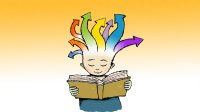Guiding Students to Develop a Flexible Mindset
The flexible mindset framework emphasizes metacognition and can help students understand the process of learning.
Your content has been saved!
Go to My Saved Content.You’re already familiar with growth mindsets and the importance of belief systems that reframe notions of intelligence and our responses to failures. But you may have struggled with how to convince your students that they are smart while encouraging them to persist in the face of setbacks. Mindsets are more than a poster on the wall. We can’t simply tell our students to “get grit.”
Flexible mindsets go beyond growth mindsets by leveraging both the self-awareness and strategies needed to actualize a growth mindset. A flexible mindset is the interaction between self-awareness, adaptive strategy use, and perseverance that empowers learners to evolve and become self-directed.
Essential Elements of a Flexible Mindset
There are three key components to the flexible mindsets approach that feed each other and propel students along the path of directing their own learning journey.
Metacognition: At the core of all deeper learning is our awareness of and ability to reflect upon our own thinking and learning, or metacognition. Self-directed learners are driven by metacognitive insights, those “uh-oh” moments when we notice that what we’re doing isn’t working and engage in deep self-reflection about our own learning.
Positive thinking: Upon this foundation we can build I can mindset messages that tell us we can always learn and get smarter and there is value in mistakes and not knowing. The flexible mindsets framework differs from growth mindsets by being explicit about fusing our encouragement to keep trying with direct instruction and feedback about adaptive strategy use.
Executive function strategies: In our model, executive function (EF) is a set of interrelated processes such as planning, working memory, self-monitoring, and thinking flexibly. We need EF processes to understand what we need to do, figure out how to get there, and make it happen. Simply put, it’s how we get stuff done.
This flexible mindset framework provides strategies you can use to give your students the tools they need to learn how to learn. Metacognitive insights and executive function strategies are the perfect partners to propel your students beyond growth mindsets.
5 Key Tools to Develop Flexible Mindsets
1. Build trusting relationships. We can begin by examining our own cultural attitudes, values, fears, and beliefs about children; how these affect our actions; and how our previous life experiences can influence current behaviors. Trust follows with the intentional use of language that tells students we are authentic, receptive, solution oriented, reliable, and committed to their needs. This lays the groundwork for co-learning and other key drivers of flexible mindsets.
2. Ground our learning in metacognition. This focuses attention on self-awareness, the perspectives of others, and what works when. Flexible mindsets extend beyond traditional measures of metacognition by building self-awareness around capacities such as curiosity, adaptability, critical thinking, complex problem-solving, and creativity.
3. Teach about the brain and mistakes. Children as young as 4 can begin to explore the brain and how we learn. Students at all levels can be taught to describe simple functions of the brain and identify their personal learning-related strengths and areas for improvement. Educators can be equipped with the science of learning: how stress can hijack the prefrontal cortex and what happens in the brain when we make mistakes.
This paves the way for us to normalize mistakes, teach students the value of not knowing, and model how to grapple with material to make it their own.
4. Provide direct instruction in learning strategies. Flexible mindsets require students to use effective strategies that are based on current evidence about how the brain learns. These strategies need to be taught purposefully, directly, and frequently for students to experience the benefits of studying smarter and appreciate the value of focusing not only on the content of what they are learning but also on how they are learning. This helps students buy into the effort required to learn and apply new strategies.
Most students have never been taught how they learn, and the strategies they come up with on their own are often ineffective. The most straightforward way to teach students about strategies is by modeling, labeling, and sharing a variety of actual strategies being used in the classroom.
5. Give feedback based on strategy use. As opposed to effort only, strategy-based feedback is specific enough that it can be measured, worked on, and used to track progress. We define flexible mindset feedback as responses that are solution-oriented, empathetic, and targeted at specific strategies. This feedback encourages us to try a different approach to a problem. Feedback is powerful when learners reflect on questions such as What strategies did I try? What am I doing that is working and not working? How many attempts did I make?
Ultimately, if we believe in equity, solutions can be found in equipping all learners with the tools they need to respond resiliently and adaptively to uncertainty and adversity. It’s time to be intentional in preparing students to be curious, make mistakes, and take risks for learning.
